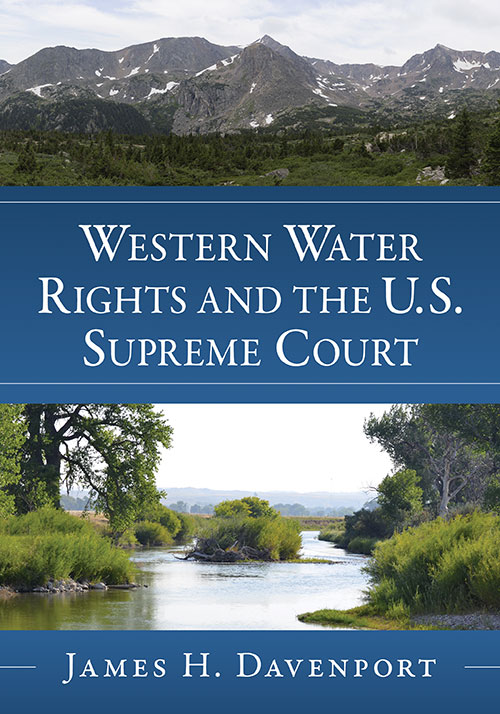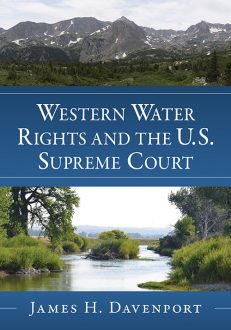Western Water Rights and the U.S. Supreme Court
$49.95
In stock
About the Book
Exploring the little-known history behind the legal doctrine of prior appropriation—“first in time is first in right”—used to apportion water resources in the western United States, this book focuses on the important case of Wyoming v. Colorado (1922). U.S. Supreme Court Associate Justice Willis Van Devanter, a former Chief Justice of Wyoming, ruled in that state’s favor, finding that prior appropriation applied across state lines—a controversial opinion influenced by cronyism. The dicta in the case, that the U.S. Government has no interest in state water allocation law, drove the balkanization of interstate water systems and resulted in the Colorado River Interstate Compact between Wyoming, Colorado, Utah, New Mexico, Arizona, Nevada and California.
The exhaustive research that has gone into this book has uncovered the secret that Associate Justice Van Devanter had waited eleven years to publish his opinion in this important, but politically self-serving, case, at last finding a moment when his senior colleagues were sufficiently absent or incapacitated to either concur or dissent. Without the knowledge of his “brethren,” save his “loyal friend” Taft, and without recusal, Van Devanter unilaterally delivered his sole opinion to the Clerk for publication on the last day of the Supreme Court’s October 1921 Term.
About the Author(s)
Bibliographic Details
James H. Davenport
Format: softcover (7 x 10)
Pages: 297
Bibliographic Info: 23 photos, notes, bibliography, index
Copyright Date: 2020
pISBN: 978-1-4766-8120-7
eISBN: 978-1-4766-4147-8
Imprint: McFarland
Table of Contents
Prologue: Of Water, Men and the Law 1
Part I. The Times 11
1. The Nation Moves West (1830–1880) 12
2. Herbert Spencer and Social Darwinism (1859–1938) 21
3. Economic Fortunes and Misfortunes (1860–1875) 23
4. The Prior Appropriation Doctrine (1840s–Present) 31
5. Equitable Apportionment (1902–Present) 36
6. Interstate Compacts (1922–Present) 38
Part II. The Man 39
Willis the Lawyer (1812–1894) 40
7. Young Willis Van Devanter 40
8. Cincinnatus (1833–1885) 46
9. Watching the Court (1870s, 1880s) 48
10. Willis Goes West (1883) 55
11. The Warren Machine (1884–1890) 60
12. Willis and the “Johnson County War” (1890–1892) 78
13. Banditti of the Plains (1893–1896) 92
Willis the Politician/Bureaucrat 94
14. Willis’ Wyoming Politics Go National (1892–1896) 94
15. Cleveland’s Second Chance, Senator Warren and the McKinley Administration (1895–1897) 96
16. Assistant Attorney General Van Devanter (1897–1903) 102
Willis the Judge 112
17. Van Devanter’s Eighth Circuit Decisions (1903–1911) 112
18. Reasonable Rail Rates, the Sherman Act (1890–1911) 114
19. The Supreme Court Turns White (1908–1911) 119
20. The Sherman Act at the Supreme Court 125
21. “Good Fellows” Willis and William (1921–1922) 130
Part III. The Laramie River Litigation 137
22. Wyoming v. Colorado (1903–1913) 138
23. Who Controls the Water? (1902–1917) 149
24. Development Under the Reclamation Act and Return to Court (1905–1922) 155
25. Judicial Harmony (1922) 164
26. Natural Resource or Interstate Commerce? (1921–1923) 170
27. Van Devanter’s Surreptitious Composition of the Opinion and Decree (1922) 173
28. Wyoming v. Colorado, Final Opinion Published (1922) 177
29. Where Was the Balance of the Court on June 5, 1922? (1922) 182
30. The Decree and Holding of Wyoming v. Colorado 188
Part IV. Implications for Water Law 193
31. What of the Merits of Wyoming v. Colorado? 194
32. What of the Effect of the Decision in Wyoming v. Colorado? 198
33. The Case for Recusal 201
Part V. Willis Van Devanter’s Justice 207
34. Van Devanter’s Indian Cases (1897–1921) 208
35. Van Devanter’s Income Tax Cases (1920–1925) 212
36. The Four Horsemen 214
37. The Measure of a Justice 221
38. Finis 228
Epilogue: That Was Then, This Is Now 231
Chapter Notes 245
Bibliography 281
Index 285
Book Reviews & Awards
“Robust and intriguing…recommended”—Choice





